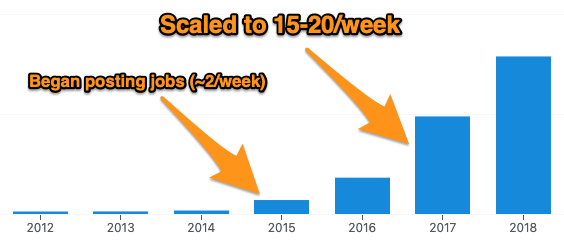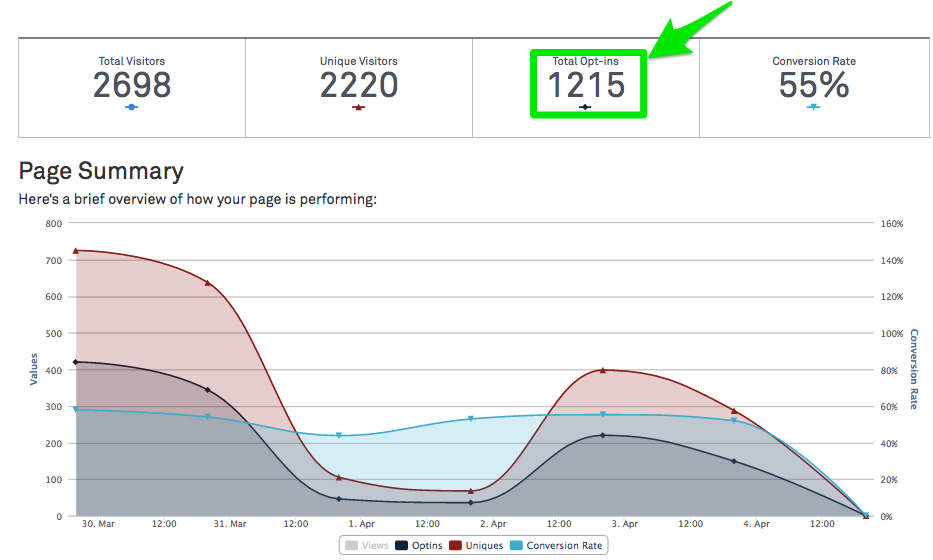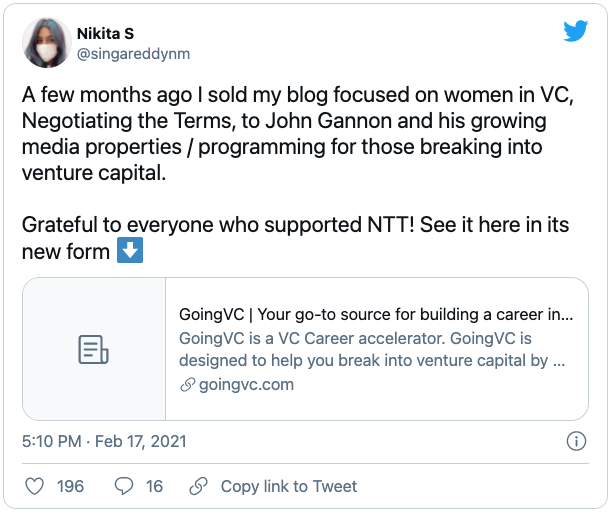
Hi there! Dan here. I think a lot of people on this list either are, or want to be creators on the internet. And there's a lot to learn about the process of becoming a professional—everything from how to get started, to how to grow something that's already working. I invited John Gannon of GoingVC to write a guest post about how he built his 20,000 subscriber list, and made over $1mm in revenue as a creator. This post breaks down what he's learned into a 4-step process—I learned a lot from it, and I think you will too.
Back in 2008, I started a blog about how to break into VC. I knew how hard it was to break into the industry and I wanted to give back. I had no idea that that blog would turn into an email list ~20,000 subscribers strong. That list led me to launch a cohort-based education program (we’re on our eighth cohort!) and community, GoingVC, as well as a related VC investment arm.
All in all, the programs, products, services, and companies I’ve created or co-founded have grossed over $1MM lifetime revenue. Yet when I started my journey as a creator, the thought of how I would monetize my work never even crossed my mind. Plugging away week after week after week, newsletter after newsletter, project after project, I was unwittingly playing the long game, well before I even knew what the long game was. Maybe not knowing exactly what it would all come to is how I ended up a 10+ year “overnight” success—a creator who’s built a platform that’s begun to look more like a business than a blog, and throws off enough income so that I can spend more time... creating.
But like any entrepreneurial creator, I’m always looking for a new challenge. Which got me thinking… Could I take another subject area I’m passionate about, become a creator in that space (like I did with VC), and get to $1MM in revenue again? What would I need to do? How would I do it more efficiently, and more quickly, than the first time around? And what would I do the exact same way?
More importantly, I wanted to share what I would recommend you do to get to $1MM+ revenue as a creator, based on the same playbook—and by learning from some of the mistakes that I’ve made.
So I boiled it all down to a 4-step process:
- Beginner mode: Steps 1 and 2 are for getting started in a way that’ll make turning your side project into a creator career a whole lot easier. (Even if you’ve already started or if you’re starting something new, it’s never a bad idea to go back to basics!)
- Pro mode: In Step 3, I’ll share what I learned and what I wish I’d done sooner to prioritize what I was building and treat it like the career it would become.
- Advanced mode: Step 4 covers something that creators rarely do, but that can generate massive benefits.
Each piece on its own will help you on your journey, whether you’re just getting started or you’re a few years in, so feel free to bite off whatever you think you can chew. Or use them all for maximum results. Let’s get started going pro!
Beginner Mode
Step 1: Not everyone’s a blogger—pick a medium that you actually love
Why? The people who tell you to “just start writing” are, well, writers! You got the advice to start a Substack from reading their Substack, didn’t you? :)
Here’s the cold, hard truth. Writing online doesn’t actually work for most aspiring creators. Just look at the evidence strewn all over the web. Hundreds of thousands of blogs, Medium publications, and Substacks that have just a few posts on them, and no audience to speak of. And it’s not surprising. I don’t mind spending hours on a post like this one, but I know this is not most people’s idea of a good time. They’d rather be out taking pictures, recording music, going out to eat, or meeting new people. But sadly, because they get sucked into the trope of “must write to build a brand,” the chance for them to share their gift with the world (and build a platform and personal brand in the process) dies on the vine.
Don’t worry, though. If the thought of writing an article makes your skin crawl, or just feels like too much work, there are so many other mediums you can use to build an audience as a creator. Jonathan Lehr and Matt Turck built their brands in the VC world by creating meet-ups (New York Enterprise Tech Meetup and Data Driven), and superconnector Laurel Touby took a similar approach with her Cereal Entrepreneurs Breakfast. Jason Gaignard built his network through his Mastermind Dinners, and Jenny Gyllander used Instagram to build a following which has transformed into a VC backed startup.
Hopefully these examples inspire you to look outside blogging and into your past for other ways you can leverage your own interests and talents to build an audience as a creator. Like, maybe growing up you were the person who always loved to make videos for your family and friends. Cool. Then maybe YouTube it is! Did you DJ or do college radio? Well, maybe a podcast would be something to think about as the focus of how you’re going to build out a platform and audience. Do you cook or love food? Start a dinner series. The possibilities are endless, and I truly believe you can make almost anything work as a medium or method as long as it’s something you actually enjoy doing.
Step 2: Avoid the tools trap
Once you pick out your medium, it’s possible you’ll need some software based tools to help you start creating or promoting what you’re working on. It’s another decision point that looks innocent enough, but can stop you in your tracks before you ever really get started. Before you spend days or weeks obsessing over the exact right tool for your needs, know that the tool you pick will have basically zero impact on your ability to bootstrap and grow your audience. And you can always switch it up later on when you’ve outgrown it. You just need to do the work and break through the resistance that’s native to any creative endeavor.
An example I love to give about why tool selection just doesn’t matter is my own newsletter. I used MadMimi as my email provider for years—it took me from zero to 10,000+ subscribers, and from zero to hundreds of thousands in revenue across all of my products and programs. A few years ago I moved over to a more full-featured email service provider, and I did spend a lot of time thinking through options at that time. But it would have been exactly the wrong thing to be thinking about on Day 1. I’m so glad that I just went with MadMimi and got started instead of spending weeks finding the “just right” tool. Because evaluating three different email providers before ever sending an email would have sucked the wind right out of my sails.
A related pitfall is focusing on automation too early. If you’re doing anything content related, you can go a long way with tools like Zapier and with virtual assistants or people you hire straight from your audience. To this day, I still have someone helping me out part-time who manually follows a process to find and then post VC jobs to my blog. I hope that shows you that you don’t need to hire a developer to build some automated machine learning thingy to post content for you, when maybe paying someone $20/hour to post stuff by hand would get you launched today (versus six months from now).
Pro Mode
Step 3: Go pro as soon as possible
One thing I didn’t realize until many years into my journey is how important it is to “go pro” before you think you’re ready. My definition of what it means to go pro comes straight from Steve Pressfield, in his book The War of Art. In fact, he devoted a whole chapter to this critical topic.
“The amateur plays for fun. The professional plays for keeps. To the amateur, the game is his avocation. To the pro it’s his vocation. The amateur plays part-time, the professional full-time. The amateur is a weekend warrior. The professional is there seven days a week.”
You don’t need to take Pressman’s words literally to get value out of the powerful mindshift he’s proposing. Here’s my version of “going pro.”
First, I stopped creating alone
I never was grinding away seven days a week on ‘creation.’ Hard to do when you are trying to have a work-life balance. But what I did do—like a pro would—was hire someone to help me out part-time with posting jobs to the blog. Doing that meant that someone was doing something to move the project forward every single day.
Here’s the tangible outcome. Going pro let me 7-10X the amount of content (specifically, VC job posts) that I was putting out on a monthly basis. As you can see, as the posting frequency increased, the growth really started to kick in:
Now there’s a team of four that work with me on various aspects of VC Careers part-time, and over the last two years I’ve paid out ~$500/month, or ~$6,000 per year, to those folks. Worth every penny.
You might be thinking that hiring someone is going to take a ton of your time. It could. But there’s a better way. Here’s my process at a high level, which allows me to only have to interview a single person for any position for which I’m hiring, whether I get 10 applicants or 100. This process was inspired by the book Code as Cards:
- Email the opportunity to my audience
- People apply
- A small number of applicants are selected to a complete a series of tasks relevant to the job (for pay)
- I interview the person who completes the tasks the best on time
- If the interview goes well I hire them to a two week trial period
- If that works, we continue!
Next, I started to pay out of my own pocket to grow.
There is one step to going pro that I neglected, and it hurt me: I was way late to the party in terms of spending money on ads to grow my email list. Like, eight years too late. I’m certain that delay cost me tens of thousands of subscribers. How do I know? Well, for a $400 investment in an ad slot on another VC newsletter, I saw results like this:
I think most brands and creators would kill for a CPA like that (less than 40 cents per subscriber). Heck, I’d kill for a CPA like that right now ;) Which goes to show that had I started investing in paid ads earlier, my email list and platform would be that much bigger today.
So how do you identify promising places to advertise what you’ve created? Start by looking at the blogs and newsletters that you love to read. My guess is that some of these are the same blogs and newsletters that the folks you’re trying to reach read, too.
If those blogs and newsletters already have ads running, they’ll make it obvious as to how one can buy a slot. No ads in sight, or no clear way to ask to buy ads? Just email the site owner directly and ask them if you could advertise with them. Most folks will come up with an option or two for you, even if they’ve never sold ads before.
As a creator on a limited budget, start small and see what works before leaning in with more dollars. What I’ve found is that most decent sized newsletters (10k-50k subs) will have sub-$1000 ad options (and maybe some sub-$500 options) that will give you a chance to dip your toe in the advertising waters without busting your budget.
How do you know when to go pro?
I don’t want you to walk away from this thinking that after you record 50 YouTube videos you need to hire a team. But I do want you to have a framework for making that decision. So here are three simple questions you can ask yourself to decide if it’s time for you to take the ‘pro’ plunge:
- Are people writing you, unsolicited, and telling you what I’m putting out—be it emails, events, Insta, whatever—is great?
- Are you doing whatever it is you are doing on the regular? Are those dinners you’re running happening monthly? Are those blog posts going out weekly? Is that Substack hitting people’s inboxes twice a month?
- Do you have a way to make sure you don’t lose touch with the people you’re engaging? Do you have a place (Twitter, email subscription form, a Discord server, etc.) to send them once they’re engaged, so that you can keep engaging with them?
If you answered yes to these questions, then there’s a good possibility it’s the right time for you to jump into going pro as a creator. And once you do that, there are even more advanced ways for you to grow your audience.
Advanced Mode
Step 4: Steal a page out of the i-banker’s playbook
No, I’m not suggesting you launch a SPAC. I’m suggesting you go out and acquire assets, and use them to help scale your platform as a creator. This is not a call to cash in your 401k to go out and buy a small business.
What I am saying is that there’s a whole world of “mini M&A” opportunities out there—companies, projects, products—that can be bought for as little as four or five figures. And even better, you can structure these deals so that you’re not paying 100% of the purchase price up front. Heck, you can even hack this so that you’re not paying a penny out of your own pocket.
The world of content is particularly ripe for this because there are terabytes worth of blogs, newsletters, and digital products that get orphaned by their creators for a variety of reasons. When you sharpen the pencil to compare this strategy versus, say, spending on paid ads to grow your audience, four or five figures to buy content or a digital product may come out as the winning investment.
Like most things in life, I learned how to do this... by doing. It started with an email thread with someone I’d come to know over the years through my newsletter. She was a fellow blogger, and had published lots of interviews with women who worked in venture capital. I had always appreciated her work, and I had noticed that the blog hadn’t been updated in a while. We were emailing about something unrelated, and then I asked her straight out: “Would you sell the blog to GoingVC?”
What happened next? Well, here’s the rough timeline of how everything went down and what I learned or did at each step:
- She said she was interested! So we had a call where I got a sense for why she’d be open to selling it, and what she thought the right price range would be. I also asked her to send along some stats about traffic and email subscribers.
- I went back to the ranch to pressure test my assumptions around the deal with our team. I wrote up a 1-pager (using a variant of my favorite 1-pager template) to communicate the opportunity and my thoughts about it -- including things like deal structure, price, and terms.
- We made an offer. She came back with something higher, but close to ours. So we met in the middle. Game on!
- The structure we settled on was pretty simple. Aside from the cash consideration, we agreed to do some specific promotion of the acquired content. And we used a template we found on FindLegalForms.com as the bones of the agreement (i.e. no lawyer needed).
Overall, it was quick, painless, and everyone was excited about the outcome:
I’m excited to do more “mini M&A” like what we did with Negotiating the Terms. And now that you have a playbook for it, I don’t see why this strategy can’t work for you to add a website, a book, a Twitter account, or a podcast, to your growing creator platform.Summing Up
If after looking at all of this it still feels unjustified to hire people to help you build your platform faster, or to buy ads, or to do mini M&A then there’s a simple exercise I’d propose to help you figure out how to get over the hump. The question is from E-Myth Revisited:
“How can I do the work I love to do rather than the work I have to do?”
After all, isn’t doing work you love the reason why you went down the creator road in the first place?
I’d love to know what’s worked for you—and what hasn’t—to get you to where you are right now. Since the best way to learn is by learning from each other, ping me on Twitter (@johnmgannon, DMs are open). Let’s continue the conversation there, so we all can learn together.
The Only Subscription
You Need to
Stay at the
Edge of AI
The essential toolkit for those shaping the future
"This might be the best value you
can get from an AI subscription."
- Jay S.
Join 100,000+ leaders, builders, and innovators

Email address
Already have an account? Sign in
What is included in a subscription?
Daily insights from AI pioneers + early access to powerful AI tools













Comments
Don't have an account? Sign up!